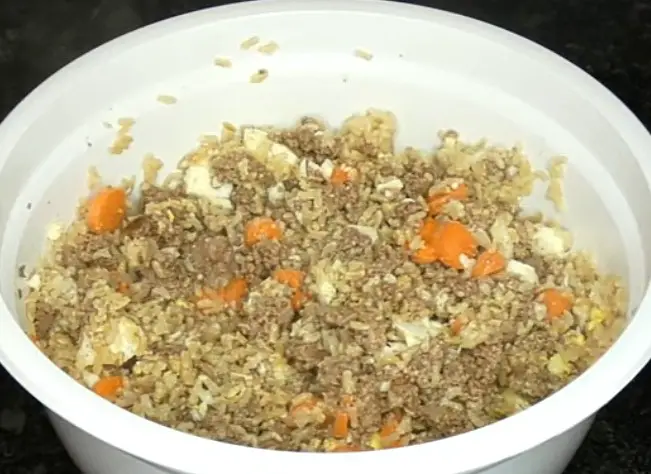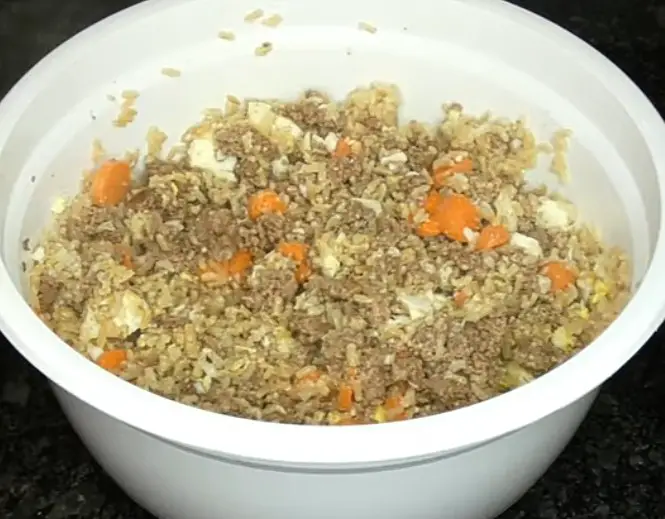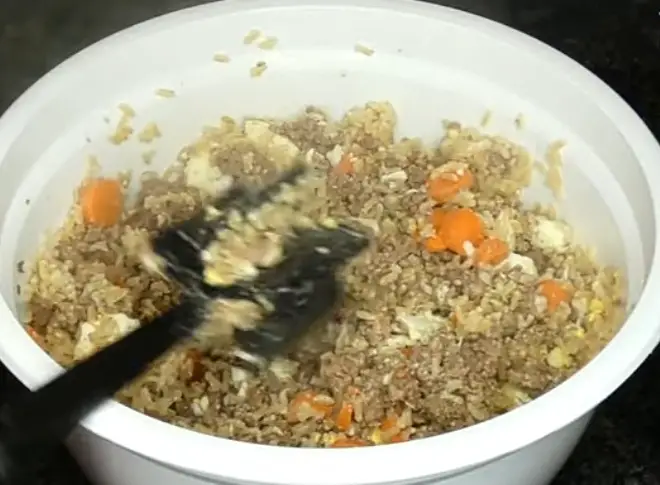My Best Homemade Dog Food Recipe

List discuss my best homemade dog food recipe… Are you tired of browsing the pet food aisle, wondering what exactly is in those cans and bags?
Well, it’s time to take matters into your own paws and whip up some homemade dog food!
In this blog post, we’ll dive into the benefits of making your own furry friend’s meals and share some delicious and nutritious recipes that will have your pup wagging their tail with delight.
Guideline to Making Homemade Dog Food

Let’s dive into the step-by-step process of preparing the best homemade dog food recipe:
Step 1: Recipe Research – Once you have a clear understanding of your dog’s dietary needs, it’s time to research and find a homemade dog food recipe that suits them best. Look for recipes that have a balance of high-quality protein, healthy fats, carbohydrates, and essential vitamins and minerals. You can find recipes in dog food cookbooks, and reputable websites, or consult with a veterinary nutritionist for a customized recipe.
Step 2: Gather Your Ingredients – First things first, let’s round up the freshest ingredients for your pup’s meal. You’ll need some high-quality protein like lean ground beef, turkey, or chicken. Grab some healthy carbohydrates such as brown rice, sweet potatoes, or quinoa. Don’t forget about those veggies – carrots, green beans, and peas are always a hit with the pooches.
Step 3: Cook the Protein and Carbohydrates – In a large pot, cook the protein until it’s no longer pink. Then, add in your chosen carbohydrates and cook them until they’re tender. This step is crucial to ensure your pup gets all the nutrients from the ingredients.
Step 4: Add the Veggies – Once your protein and carbs are cooked, toss in the veggies. These will add a pop of color and a dose of essential vitamins and minerals to the mix. Cook them until they’re tender but still have a bit of crunch.
Step 5: Mix and Cool – Combine all the cooked ingredients in a large bowl and give them a good mix. Let the mixture cool down to room temperature before portioning it out for your dog. It’s important to make sure the food isn’t too hot for those sensitive pup tongues!
Step 6: Serve and Store – Once the homemade dog food has cooled down, serve up a portion for your furry pal. If you have leftovers, portion them out into meal-sized servings and store them in the fridge or freezer for later. Just make sure to use them within a few days or freeze them for longer storage.
My Best Homemade Dog Food Recipe

Here is the step-by-step process of my best homemade dog food recipe you should try:
Step 1: Gather the ingredients and equipment
Before you begin, make sure you have all the necessary ingredients and equipment ready. For this recipe, you’ll need:
- 1 pound of ground turkey
- 2 hard-boiled eggs
- 6 cups of water
- 2 cups of brown rice
- 1 teaspoon of dried rosemary
- ½ (16 ounce) package of frozen broccoli, carrots, and cauliflower combination
- 3 tablespoons of coconut oil
- A large pot for cooking the food
- A cutting board and a knife for chopping the vegetables
- A mixing spoon for stirring the ingredients
Step 2: Cook the ground turkey
Place the large pot on the stove over medium heat and add the ground turkey. Cook it until it’s browned and no longer pink. Stir occasionally to ensure even cooking.
Step 3: Prepare the hard-boiled eggs
Peel the hard-boiled eggs and chop them into small pieces. Set them aside for later.
Step 4: Cook the brown rice
In the same pot as the ground turkey, add the water and brown rice. Bring it to a boil over high heat, then reduce the heat to low and cover the pot. Let the rice simmer for about 30 minutes or until it’s cooked and tender. Stir occasionally to prevent sticking.
Step 5: Add the vegetables
Once the rice is cooked, add the frozen broccoli, carrots, and cauliflower combination to the pot. Stir well to combine all the ingredients.
Step 6: Season with dried rosemary and coconut oil
Sprinkle the dried rosemary over the mixture in the pot. Then, add the coconut oil. Stir everything thoroughly to distribute the seasonings and oil evenly.
Step 7: Simmer and cool
Cover the pot and let the mixture simmer on low heat for an additional 10-15 minutes. This will help the flavors meld together. After simmering, turn off the heat and allow the homemade dog food to cool completely.
Step 8: Serve or store
Once the homemade dog food has cooled down, you can serve it to your furry friend. For storage, divide the food into portions suitable for your dog’s meal sizes. You can refrigerate the portions you’ll use within a few days and freeze the rest for longer-term storage.
Read more about human food dogs can eat.
Related Questions
Can I feed my dog homemade food instead of commercial dog food?
Absolutely! Homemade dog food can be a great alternative to commercial dog food. However, it’s important to ensure that your homemade meals provide all the necessary nutrients for your furry friend’s overall health and well-being. Consult with a veterinarian or a canine nutritionist to create a balanced and appropriate diet plan.
What ingredients should I include in homemade dog food?
When preparing homemade dog food, it’s crucial to include a variety of ingredients that provide essential nutrients. Some common ingredients to consider are lean meats (such as chicken, turkey, or beef), vegetables (like carrots, peas, and sweet potatoes), whole grains (such as brown rice or quinoa), and healthy fats (like fish oil or olive oil). Avoid using ingredients that are toxic to dogs, such as onions, garlic, grapes, and chocolate.
How do I ensure that my homemade dog food is nutritionally balanced?
To ensure that your homemade dog food is nutritionally balanced, it’s recommended to consult with a professional, such as a veterinarian or a canine nutritionist. They can help you determine the appropriate quantities of protein, carbohydrates, fats, vitamins, and minerals needed for your dog’s specific breed, age, and health condition. They may also suggest adding supplements to meet any nutritional gaps.
Are there any risks associated with feeding homemade dog food?
While homemade dog food can be a healthy choice, there are some risks to be aware of. One of the main concerns is the potential for an imbalanced diet, which may lead to nutrient deficiencies or excesses. It’s crucial to follow a well-formulated recipe or seek professional guidance to avoid these issues. Additionally, proper food handling and storage are essential to prevent bacterial contamination and foodborne illnesses.
Can I feed my dog raw food as homemade dog food?
Feeding a raw food diet to dogs, also known as a “raw diet” or “BARF diet” (Biologically Appropriate Raw Food), is a personal choice. While some dog owners advocate for the benefits of feeding raw, it’s important to note that raw food carries a higher risk of bacterial contamination. If you choose to feed raw, make sure to handle and store the ingredients properly to minimize the risk of foodborne illnesses.
How do I transition my dog from commercial dog food to homemade dog food?
When transitioning your dog from commercial dog food to homemade dog food, it’s essential to do it gradually. Start by replacing a small portion of your dog’s regular food with homemade food and gradually increase the proportion over several days or weeks. This helps your dog’s digestive system adapt to the new diet without causing any stomach upset. Monitor your dog’s health and consult with a veterinarian if you notice any changes or concerns during the transition period.
Read more about human food dogs cannot eat.
Conclusion
In conclusion, making homemade dog food is a paw-some way to ensure your furry friend is getting the best nutrition possible.
Not only does it give you control over the ingredients, but it also allows you to cater to your dog’s specific dietary needs.
So, why not give it a try and see your pup’s tail wag with delight over their homemade meals? Woof-tastic!
